steering MINI Hardtop 2 Door 2005 User Guide
[x] Cancel search | Manufacturer: MINI, Model Year: 2005, Model line: Hardtop 2 Door, Model: MINI Hardtop 2 Door 2005Pages: 165, PDF Size: 2.32 MB
Page 58 of 165
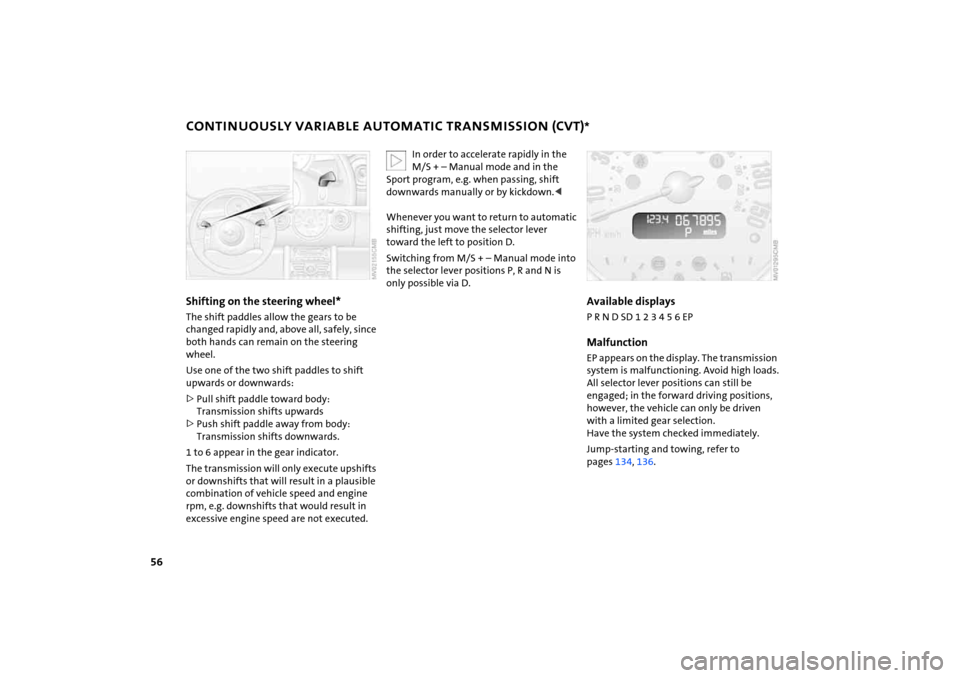
56
CONTINUOUSLY VARIABLE AUTOMATIC TRANSMISSION (CVT)
*
Shifting on the steering wheel* The shift paddles allow the gears to be
changed rapidly and, above all, safely, since
both hands can remain on the steering
wheel.Use one of the two shift paddles to shift
upwards or downwards:>Pull shift paddle toward body:
Transmission shifts upwards>Push shift paddle away from body:
Transmission shifts downwards.1 to 6 appear in the gear indicator.
The transmission will only execute upshifts
or downshifts that will result in a plausible
combination of vehicle speed and engine
rpm, e.g. downshifts that would result in
excessive engine speed are not executed.
In order to accelerate rapidly in the M/S
+ – Manual mode and in the
Sport program, e.g. when passing, shift
downwards manually or by kickdown.<
Whenever you want to return to automatic
shifting, just move the selector lever
toward the left to position D.Switching from M/S
+ – Manual mode into
the selector lever positions P, R and N is
only possible via D.
Available displaysP R N D SD 1 2 3 4 5 6 EPMalfunctionEP appears on the display. The transmission
system is malfunctioning. Avoid high loads.
All selector lever positions can still be
engaged; in the forward driving positions,
however, the vehicle can only be driven
with a limited gear selection.
Have the system checked immediately.Jump-starting and towing, refer to
pages
134
, 136
.
Page 63 of 165

61
OVERVIEW REPAIRS OPERATIONCONTROLS DATA INDEX
CRUISE CONTROL
*
On the multifunction steering wheel
and sports steering wheelAbove approx. 20
mph
/ 30
km/h the cruise
control maintains and stores any desired
speed.
Do not use cruise control on twisting roads, when high traffic density pre
-
vents driving at a constant speed, or when
the road surface does not permit driving at
a constant speed, e.g. due to snow, rain, ice,
or loose surfaces.<
To activate via the multifunction steering wheelFrom ignition key position
1:
Press button
2.
The indicator lamp in the instrument clus
-
ter lights up.
Cruise control is active.To activate via the sports steering
wheel1. Start the engine2. Press button
2.
The indicator lamp in the instrument clus
-
ter lights up.
Cruise control is active.
To deactivate Press button
2 repeatedly until the indica
-
tor lamp goes out.The cruise control is deactivated when the
ignition key is turned to position
0.
The stored speed is cleared.To maintain and store speed or to
acceleratePress button
3.
The system maintains and stores the cur
-
rent vehicle speed. Every time you tap the
button, the speed increases by approx.
1 mph
/ 2
km/h.
Page 64 of 165

62
CRUISE CONTROL
*
Press and hold button
3.
The vehicle accelerates without pressure
on the accelerator pedal. When you release
the button, the system maintains and
stores the current speed.
If, on a downhill gradient, the engine braking effect is not sufficient, the
controlled speed may be exceeded. Speed
can drop on uphill grades if the engine out
-
put is insufficient.
If you are already driving with active cruise
control, the speed is decreased by approx.
1 mph
/ 2
km/h every time you briefly tap
the button.
Press and hold button
4.
With the cruise control active, the system
automatically reduces the throttle opening
to slow the vehicle. When you release the
button, the system maintains and stores
the current speed.To cancel the cruise controlThe cruise control is automatically can
-
celed:
>When the brakes are applied>When the clutch pedal is depressed>If the cruising speed is either exceeded or
not met for an extended length of time,
for example if you press the accelerator
pedal and exceed the stored speed.The indicator lamp stays lit.
You can use the cruise control again as
required.On the multifunction steering wheel, the
cruise control can be interrupted manually:When the system is activated, press
button
2.
To continue cruise controlPress button
1.
The vehicle accelerates to and maintains
the last speed stored.
Page 71 of 165
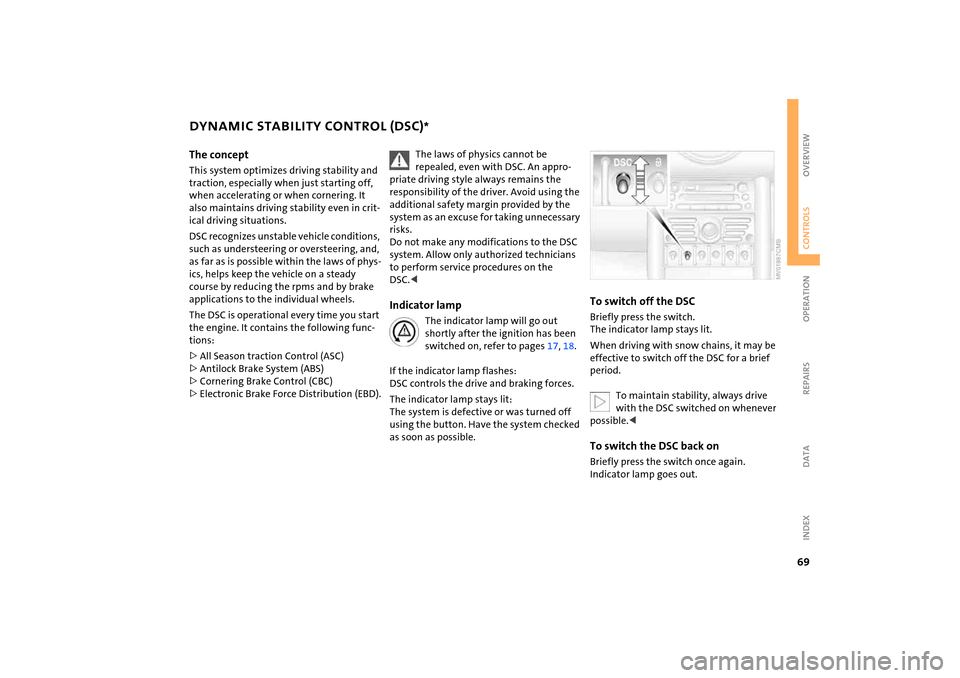
69
OVERVIEW REPAIRS OPERATIONCONTROLS DATA INDEX
DYNAMIC STABILITY CONTROL (DSC)
*
The conceptThis system optimizes driving stability and
traction, especially when just starting off,
when accelerating or when cornering. It
also maintains driving stability even in crit
-
ical driving situations.DSC recognizes unstable vehicle conditions,
such as understeering or oversteering, and,
as far as is possible within the laws of phys
-
ics, helps keep the vehicle on a steady
course by reducing the rpms and by brake
applications to the individual wheels.The DSC is operational every time you start
the engine. It contains the following func
-
tions:>All Season traction Control (ASC)>Antilock Brake System (ABS)>Cornering Brake Control (CBC)>Electronic Brake Force Distribution (EBD).
The laws of physics cannot be repealed, even with DSC. An appro
-
priate driving style always remains the
responsibility of the driver. Avoid using the
additional safety margin provided by the
system as an excuse for taking unnecessary
risks.
Do not make any modifications to the DSC
system. Allow only authorized technicians
to perform service procedures on the
DSC.
switched on, refer to pages
17, 18
.
If the indicator lamp flashes:
DSC controls the drive and braking forces. The indicator lamp stays lit:
The system is defective or was turned off
using the button. Have the system checked
as soon as possible.
To switch off the DSCBriefly press the switch.
The indicator lamp stays lit.When driving with snow chains, it may be
effective to switch off the DSC for a brief
period.
To maintain stability, always drive with the DSC switched on whenever
possible.<
To switch the DSC back onBriefly press the switch once again.
Indicator lamp goes out.
Page 72 of 165

70
ANTILOCK BRAKE SYSTEM (ABS) The concept The ABS keeps the wheels from locking
while braking, thereby enhancing active
driving safety. ABS also includes Electronic Brake Force
Distribution (EBD).Safe brakingYour vehicle is equipped with ABS as a stan
-
dard feature. The best way to brake the
vehicle in critical situations requiring brak
-
ing is to apply maximum pressure to the
brake pedal: panic stop.
Since the vehicle remains maneuverable,
you can still go around any obstacles with
the smallest possible steering movements.The pulsation of the brake pedal, together
with the sound of hydraulic regulation,
indicates to you that ABS is actively taking
effect.
Cornering Brake Control (CBC)Cornering Brake Control (CBC) is an
enhancement of ABS that improves vehicle
stability especially when braking during
cornering.
When the vehicle is being braked, the rear
wheels are relieved from load, and this can
cause the vehicle to oversteer in curves.
CBC counteracts this by making use of uni
-
lateral braking pressure to generate a sta
-
bilizing counter torque while braking out
-
side of the ABS control range.Electronic Brake Force Distribution
(EBD)In order to achieve a short braking distance
when the vehicle is fully loaded, your vehi
-
cle is equipped with relatively large brakes
on the rear axle. EBV continuously moni
-
tors the speeds of the rear wheels in rela
-
tion to the front wheels in order to prevent
overbraking of the rear wheels even when
the vehicle has a light load. If the rear
wheels tend to lock, the EBV controls their
slip, ensuring operating stability.
Page 74 of 165
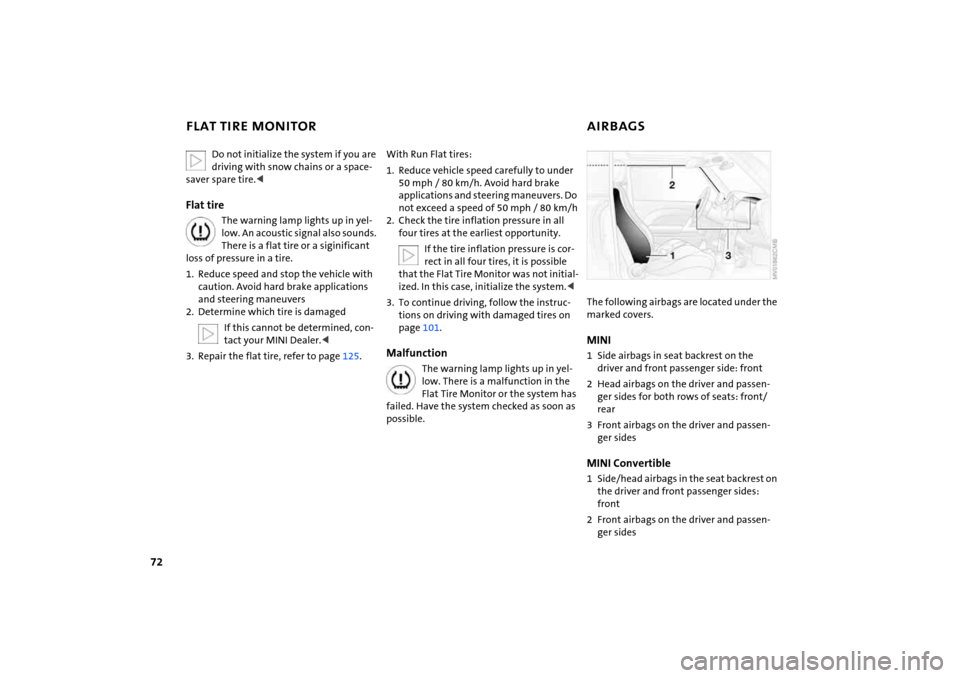
72
FLAT TIRE MONITOR
AIRBAGS
Do not initialize the system if you are driving with snow chains or a space-
saver spare tire.<
Flat tire
The warning lamp lights up in yel
-
low. An acoustic signal also sounds.
There is a flat tire or a siginificant
loss of pressure in a tire.
1. Reduce speed and stop the vehicle with
caution. Avoid hard brake applications
and steering maneuvers2. Determine which tire is damaged
If this cannot be determined, con
-
tact your MINI Dealer.<
3. Repair the flat tire, refer to page
125
.
With Run Flat tires:1. Reduce vehicle speed carefully to under
50
mph
/ 80 km/h. Avoid hard brake
applications and steering maneuvers. Do
not exceed a speed of 50
mph
/ 80
km/h
2. Check the tire inflation pressure in all
four tires at the earliest opportunity.
If the tire inflation pressure is cor
-
rect in all four tires, it is possible
that the Flat Tire Monitor was not initial
-
ized. In this case, initialize the system.<
3. To continue driving, follow the instruc
-
tions on driving with damaged tires on
page
101
.
Malfunction
The warning lamp lights up in yel
-
low. There is a malfunction in the
Flat Tire Monitor or the system has
failed. Have the system checked as soon as
possible.
The following airbags are located under the marked covers.MINI 1 Side airbags in seat backrest on the
driver and front passenger side: front2 Head airbags on the driver and passen
-
ger sides for both rows of seats: front/
rear3 Front airbags on the driver and passen
-
ger sidesMINI Convertible1 Side/head airbags in the seat backrest on
the driver and front passenger sides:
front2 Front airbags on the driver and passen
-
ger sides
Page 95 of 165
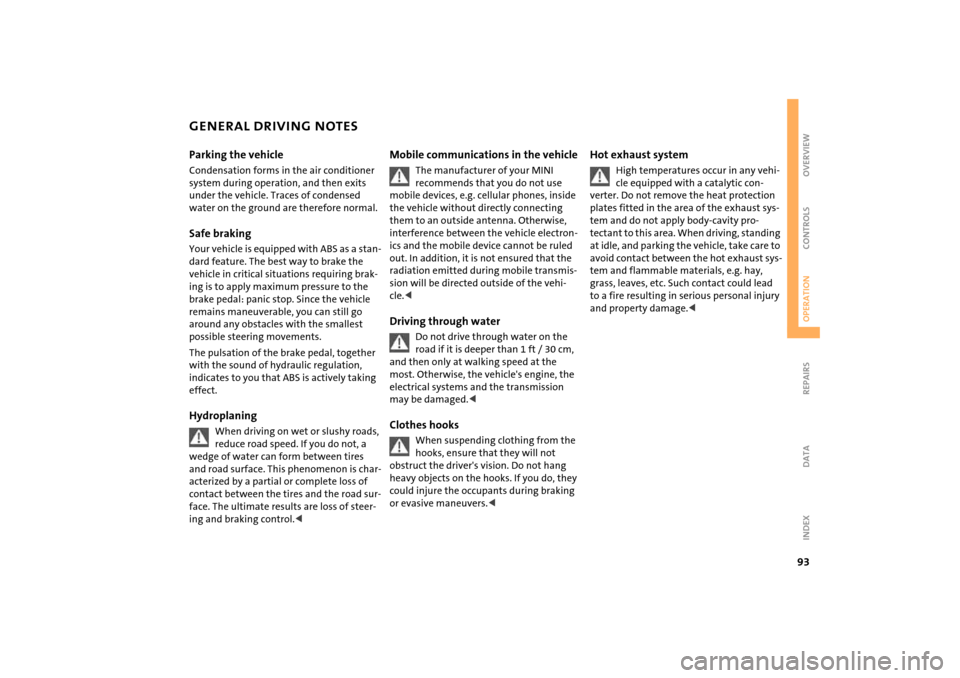
93
OVERVIEW REPAIRSOPERATIONCONTROLS DATA INDEX
GENERAL DRIVING NOTESParking the vehicle Condensation forms in the air conditioner
system during operation, and then exits
under the vehicle. Traces of condensed
water on the ground are therefore normal.Safe braking Your vehicle is equipped with ABS as a stan
-
dard feature. The best way to brake the
vehicle in critical situations requiring brak
-
ing is to apply maximum pressure to the
brake pedal: panic stop. Since the vehicle
remains maneuverable, you can still go
around any obstacles with the smallest
possible steering movements. The pulsation of the brake pedal, together
with the sound of hydraulic regulation,
indicates to you that ABS is actively taking
effect. Hydroplaning
When driving on wet or slushy roads, reduce road speed. If you do not, a
wedge of water can form between tires
and road surface. This phenomenon is char
-
acterized by a partial or complete loss of
contact between the tires and the road sur
-
face. The ultimate results are loss of steer
-
ing and braking control.<
Mobile communications in the vehicle
The manufacturer of your MINI
recommends that you do not use
mobile devices, e.g. cellular phones, inside
the vehicle without directly connecting
them to an outside antenna. Otherwise,
interference between the vehicle electron
-
ics and the mobile device cannot be ruled
out. In addition, it is not ensured that the
radiation emitted during mobile transmis
-
sion will be directed outside of the vehi
-
cle.
ft / 30 cm,
and then only at walking speed at the
most. Otherwise, the vehicle's engine, the
electrical systems and the transmission
may be damaged.<
Clothes hooks
When suspending clothing from the hooks, ensure that they will not
obstruct the driver's vision. Do not hang
heavy objects on the hooks. If you do, they
could injure the occupants during braking
or evasive maneuvers.<
Hot exhaust system
High temperatures occur in any vehi
-
cle equipped with a catalytic con
-
verter. Do not remove the heat protection
plates fitted in the area of the exhaust sys
-
tem and do not apply body-cavity pro
-
tectant to this area. When driving, standing
at idle, and parking the vehicle, take care to
avoid contact between the hot exhaust sys
-
tem and flammable materials, e.g. hay,
grass, leaves, etc. Such contact could lead
to a fire resulting in serious personal injury
and property damage.<
Page 98 of 165
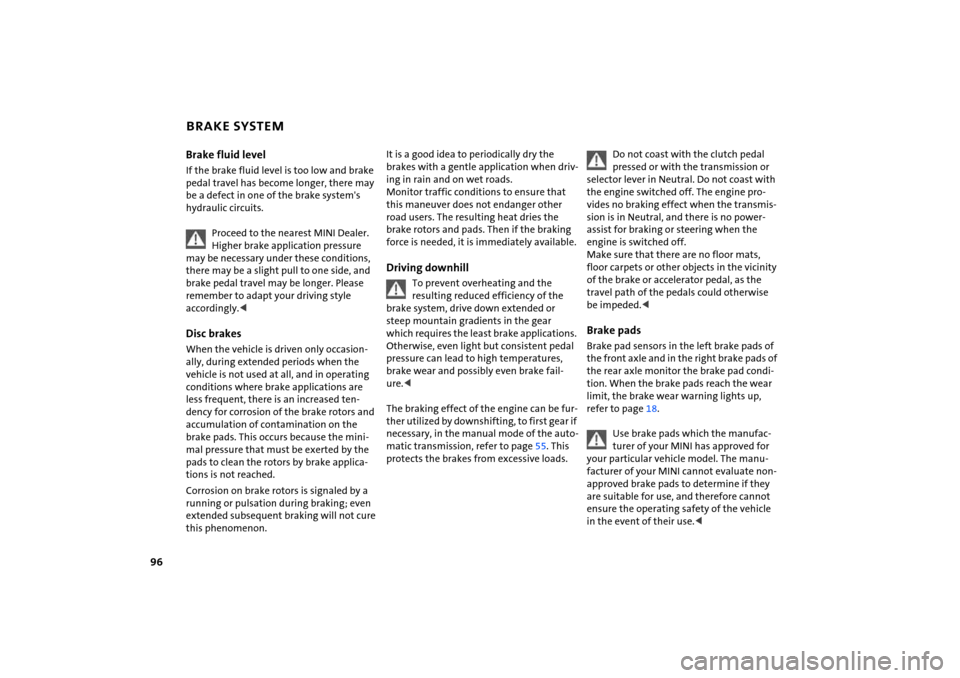
96
BRAKE SYSTEMBrake fluid levelIf the brake fluid level is too low and brake
pedal travel has become longer, there may
be a defect in one of the brake system's
hydraulic circuits.
Proceed to the nearest MINI Dealer. Higher brake application pressure
may be necessary under these conditions,
there may be a slight pull to one side, and
brake pedal travel may be longer. Please
remember to adapt your driving style
accordingly.<
Disc brakesWhen the vehicle is driven only occasion
-
ally, during extended periods when the
vehicle is not used at all, and in operating
conditions where brake applications are
less frequent, there is an increased ten
-
dency for corrosion of the brake rotors and
accumulation of contamination on the
brake pads. This occurs because the mini
-
mal pressure that must be exerted by the
pads to clean the rotors by brake applica
-
tions is not reached. Corrosion on brake rotors is signaled by a
running or pulsation during braking; even
extended subsequent braking will not cure
this phenomenon.
It is a good idea to periodically dry the
brakes with a gentle application when driv
-
ing in rain and on wet roads.
Monitor traffic conditions to ensure that
this maneuver does not endanger other
road users. The resulting heat dries the
brake rotors and pads. Then if the braking
force is needed, it is immediately available.Driving downhill
To prevent overheating and the resulting reduced efficiency of the
brake system, drive down extended or
steep mountain gradients in the gear
which requires the least brake applications.
Otherwise, even light but consistent pedal
pressure can lead to high temperatures,
brake wear and possibly even brake fail
-
ure.
ther utilized by downshifting, to first gear if
necessary, in the manual mode of the auto
-
matic transmission, refer to page
55. This
protects the brakes from excessive loads.
Do not coast with the clutch pedal pressed or with the transmission or
selector lever in Neutral. Do not coast with
the engine switched off. The engine pro
-
vides no braking effect when the transmis
-
sion is in Neutral, and there is no power-
assist for braking or steering when the
engine is switched off.
Make sure that there are no floor mats,
floor carpets or other objects in the vicinity
of the brake or accelerator pedal, as the
travel path of the pedals could otherwise
be impeded.
the rear axle monitor the brake pad condi
-
tion. When the brake pads reach the wear
limit, the brake wear warning lights up,
refer to page
18.
Use brake pads which the manufac
-
turer of your MINI has approved for
your particular vehicle model. The manu
-
facturer of your MINI cannot evaluate non-
approved brake pads to determine if they
are suitable for use, and therefore cannot
ensure the operating safety of the vehicle
in the event of their use.<
Page 99 of 165
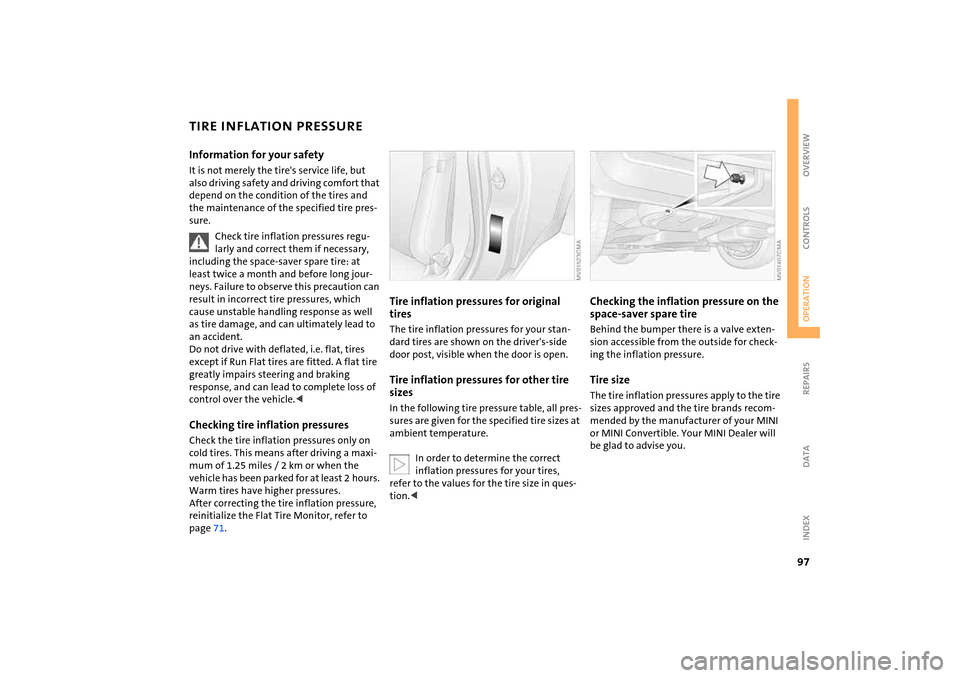
97
OVERVIEW REPAIRSOPERATIONCONTROLS DATA INDEX
TIRE INFLATION PRESSURE Information for your safetyIt is not merely the tire's service life, but
also driving safety and driving comfort that
depend on the condition of the tires and
the maintenance of the specified tire pres
-
sure.
Check tire inflation pressures regu
-
larly and correct them if necessary,
including the space-saver spare tire: at
least twice a month and before long jour
-
neys. Failure to observe this precaution can
result in incorrect tire pressures, which
cause unstable handling response as well
as tire damage, and can ultimately lead to
an accident.
Do not drive with deflated, i.e. flat, tires
except if Run Flat tires are fitted. A flat tire
greatly impairs steering and braking
response, and can lead to complete loss of
control over the vehicle.
-
mum of 1.25
miles / 2
km or when the
vehicle has been parked for at least 2
hours.
Warm tires have higher pressures.
After correcting the tire inflation pressure,
reinitialize the Flat Tire Monitor, refer to
page
71.
Tire inflation pressures for original tiresThe tire inflation pressures for your stan
-
dard tires are shown on the driver's-side
door post, visible when the door is open.Tire inflation pressures for other tire
sizesIn the following tire pressure table, all pres
-
sures are given for the specified tire sizes at
ambient temperature.
In order to determine the correct inflation pressures for your tires,
refer to the values for the tire size in ques
-
tion.<
Checking the inflation pressure on the space-saver spare tireBehind the bumper there is a valve exten
-
sion accessible from the outside for check
-
ing the inflation pressure.Tire sizeThe tire inflation pressures apply to the tire
sizes approved and the tire brands recom
-
mended by the manufacturer of your MINI
or MINI Convertible. Your MINI Dealer will
be glad to advise you.
Page 104 of 165

102
RUN FLAT TIRES
*
NEW WHEELS AND TIRES
If there is a total loss of tire inflation pres
-
sure, 0
psi
/ 0 kPa, or obvious tire damage,
you can gauge the mileage for continued
driving on the basis of the following indica
-
tions:>With a light load:
1 to 2 persons without luggage:
approx. 155
miles
/ 250
km
>With a medium load:
2 persons, full luggage compartment, or
4 persons without luggage:
approx. 90 miles
/ 150 km.
>With a full load:
4 persons or more, full luggage compart
-
ment:
approx. 30
miles
/ 50 km.
Drive cautiously. Do not exceed a speed of 50
mph
/ 80
km/h. In case of
tire pressure loss you must expect changes
in vehicle handling such as lower track sta
-
bility during braking, longer braking dis
-
tances and changes in self-steering proper
-
ties when close to the handling limit.
For safety reasons, the manufacturer of
your vehicle recommends not having dam
-
aged Run Flat tires repaired. In this case,
consult your MINI dealer.<
Tire change set
In case of a flat tire, the tire change set is not needed, since your vehicle
has Run Flat tires.
When changing a tire, always observe the
safety measures and the procedure for
changing tires starting on page
125
.<
Your vehicle is additionally equipped with a
tire change set.In the MINI COOPER and MINI COOPER Con
-
vertible this is located in the luggage com
-
partment under the floor mat.
In the MINI COOPER
S and MINI COOPER S
Convertible, the tire change set is located in
a separate bag which is attached to the
lashing eyelets on the luggage compart
-
ment floor by means of tie-down straps.
Have new wheels and tires mounted only by a tire specialist. Work that is
improperly carried out could result in con
-
sequential damage and pose safety haz
-
ards.
-
tion for your vehicle.
Have the wheels balanced after each tire or
wheel replacement. The correct wheel and tire combination is
also important for various systems that
would otherwise be impaired, e.g. ABS or
DSC.
The manufacturer of your vehicle rec
-
ommends that you avoid using
retread tires, as this could impair driving
safety. This is due to the possible variations
in casing structures and, in some cases, to
their extreme age, which can lead to a
decrease in their durability.<